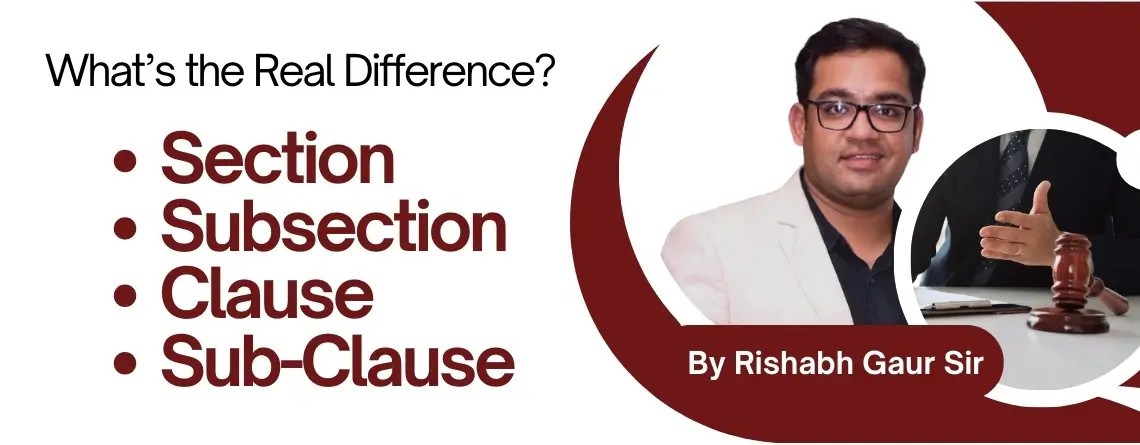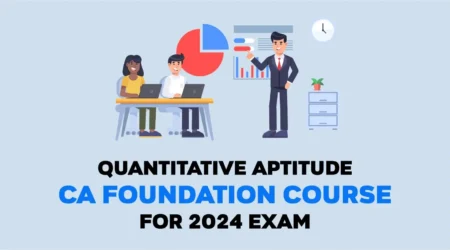Section, Subsection, Clause & Sub-Clause – What’s the Real Difference?
If you’re a CA Foundation student, you’ve definitely faced this:
“Section 2(1)(a)(iv) says this…”
And your brain goes:
“Bro… is this Math or Law? Why so many brackets?!”
Don’t worry – today we’ll break this down in the simplest way, using a clear, logical approach (with a little Hinglish spice), so you never get confused again!
First, Understand the Structure of Law
The entire law is like a huge book of paragraphs. But in the legal world, we don’t call them “paragraphs”. We call them:
– Sections
Just like your textbook has page numbers, a law book has section numbers.
Every section is like a main point or main paragraph. For example:
- Section 2 of the Indian Contract Act
- Section 15 of the LLP Act
These help us find legal content faster. That’s why giving a section number reference is super important in answers – not just for understanding, but also to impress the examiner!
Watch on YouTube:
But Wait – What Are Subsections, Clauses & Sub-Clauses?
A section can be broken down into smaller parts:
Subsection – like (1), (2), (3)
A subsection is the first level of breakdown inside a section.
Clause – like (a), (b), (c)
A clause is usually inside a subsection – adding more details.
Sub-Clause – like (i), (ii), (iii)
A sub-clause is even more specific – mostly found inside clauses.
Read Also: Understanding Court Judgements & Case Studies in CA Foundation Business Law
But the REAL Confusion?
A lot of YouTube teachers say:
“If something is written as 2(1)(a), then 2 is section, (1) is subsection, (a) is clause… simple!”
But here’s the truth:
This formula does NOT work everywhere.
In one Act, (1) might be a subsection.
In another Act, (1) might actually be a clause!
In some laws, even (a) is used for subsections.
So how do you know what’s what?
Read Also: ICAI CA Foundation Eligibility
The Smart Way to Identify Each Part
Forget the bracket formula.
Focus on the meaning of the line.
If the line makes complete sense on its own – it’s a Clause or Sub-Clause.
It stands alone. You don’t need to read anything else to understand it.
If it depends on the line above – it’s a Subsection.
You need context to understand it fully.
Example Time:
Let’s say you’re reading:
Section 15(2)
And it just says:
“Undesirable.”
Wait, what? That’s not a complete sentence. You need to read Section 15(1) or the heading to make sense of it.
So here, (2) is a subsection, not an independent clause.
Another Example:
Section 25(1)(a)(ii)
Here’s how to break it down (but with understanding):
- 25 = Section
- (1) = Could be a subsection or clause – check the full sentence.
- (a) = Clause (usually), inside (1)
- (ii) = Sub-clause, very specific point
But again – don’t blindly believe the formula. Read and understand. That’s the real way.
Read Also: ICAI CA Foundation Registration Date
Why Remembering Section Numbers Matters in CA Foundation?
Because:
- It helps your answers look professional.
- Examiners get impressed – they see you’ve studied the actual law.
- It helps you navigate the Bare Act easily.
Let’s be real – two students write the same answer.
One writes, “As per law…”
The other writes, “As per Section 25 of the Indian Contract Act…”
Who do you think scores more?
Exactly.
Final Tip: Don’t Just Mug Formulas. Use Logic.
The so-called formula:
Section → Subsection → Clause → Sub-Clause
…might work sometimes. But law isn’t math. It’s about interpretation.
Ask yourself:
- Does this line make sense alone?
- Do I need to read above to understand it?
If it makes sense alone – likely a clause.
If it needs context – probably a subsection.
That’s your golden rule!
Read Also: ICAI CA Foundation Examination Form Last Date
In Short (CA Foundation Style Recap)
| Term | What it is | Example |
|---|---|---|
| Section | Main paragraph in the Act | Section 2 |
| Subsection | First level of detail | Section 2(1) |
| Clause | Inside subsection (gives points) | Section 2(1)(a) |
| Sub-Clause | More detailed point inside clause | Section 2(1)(a)(i) |
Read Also: ICAI CA Foundation Admit Card Date
Final Words – Study Smart, Not Just Hard
Don’t fall into the trap of memorizing bracket formulas without understanding the logic.
Read with meaning. Interpret with clarity.
And trust your brain – it’s smarter than a formula!
Best of luck for your CA Foundation exams!
You’ve got this.
This complete explanation is done by Rishabh Gaur Sir, one of our best CA Foundation Faculties











Leave a Reply